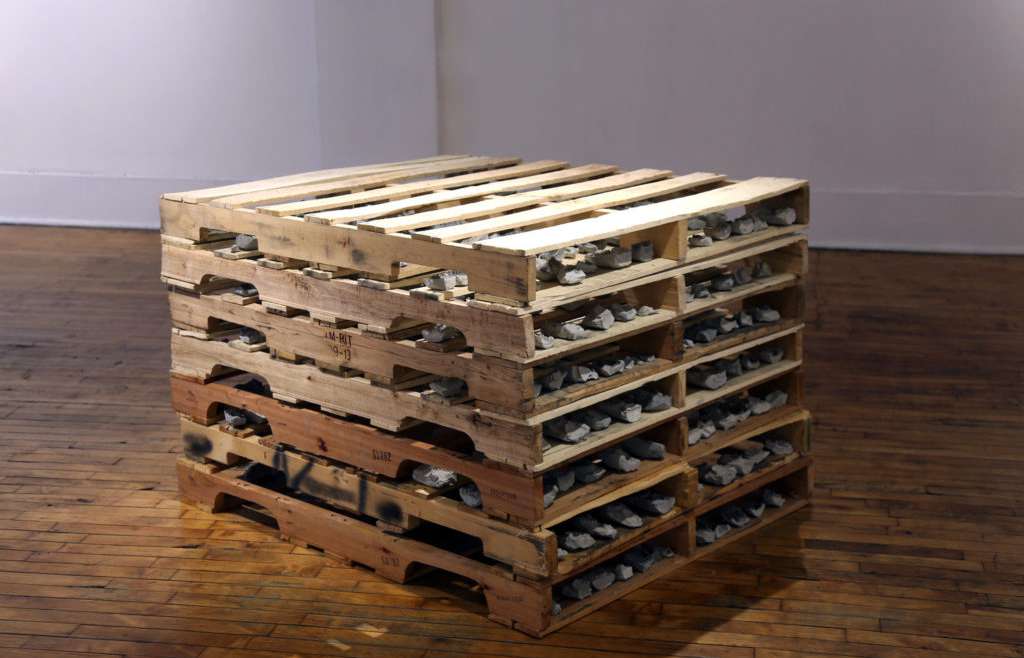hundreds of types of wood pallets, which are suited to a range of purposes. Hardwoods such as mahogany, maple, oak, teak and walnut are classic examples of ancient wood pallets often used in former times to make furniture; however, softwoods such as pine, Douglas fir, spruce and yew are used in many more applications, with pine being the most widely-grown and used wood today and often utilised in wood pallets.
What is pallet?
A pallet is a horizontal platform, typically affixed to a superstructure and a bottom deck which allows it to be lifted and moved by material handling equipment such as lift trucks and conveyors as well as to placed in appropriate storage systems and transport vehicles.
The pallet provides the base for assembling, storing, handling and transporting materials and products. Additionally, a pallet provides protection to the product on it.
The pallet is the most common base for the unit load. The unit load is a system which includes the pallet, goods stacked atop it, as well as the stretch wrap, adhesive, pallet collar, or other means of unit load stabilization.The history of pallet has been integral to the development of modern logistics. For example, pallet reuse in the supply chain became increasingly practised. The pallet pooling concept began to be seriously discussed during this time and has evolved into a key strategy for pallet suppliers.


What materials are used for pallets?
There are various common pallet materials.The wood pallet dominates the marketplace, followed by other materials, including plastic, paper, wood composite and metal pallets.
Wood pallets offer a great combination of weight, stiffness, durability and cost. In addition, there is a widespread pallet recycling infrastructure which helps promote the refurbishment and reuse of wood pallets. Custom pallets sizes can be easily fabricated from timber components. Plastic pallets typically are more expensive than wood pallets for comparable applications but are valued for such attributes as extreme durability, the precision of manufacture, and ease of sanitation.
What are the main wood pallet sizes?
Although pallets may be fabricated to various custom sizes, there are some typical sizes that are most commonly used. It should be pointed out that in describing the size of pallets, one starts with the stringer or stringer board length, first, followed by the pallet width, typically the length of the deck boards.The main pallet size or pallet dimension is 48×40 inches.
There are six pallet sizes recognized by the manufacture of wood pallets. Here is a list, including the region most commonly used:
- 1219×1016 (48×40 inches) – North America
- 1000×1200 – Europe and Asia
- 1165×1165 – Australia
- 1067×1067 – North America, Europe, and Asia
- 1100×1100 – Asia
- 800×1200 – Europe
Choosing wood for the best pallets
While pallets can be made from a variety of different woods, their composition often depends on their country of origin. This is because pallets are an example of just one part of a much larger supply system. Pallet makers are looking for a wood that is not only fit for purpose but also readily available. When a wood supply is high and readily available, the supply chain to make the pallets is consistent and – most importantly – the price of the raw product is cheap.
In the US, the world’s largest producer of wooden pallets, the two wood types most frequently used for pallet wood are oak and pine. This may come as a surprise to some, as oak is a hardwood and pine a softwood; however, whether a wood is a hardwood or softwood has very little to do with its robustness or durability. These terms refer to a wood’s physical structure alone.
What’s the difference between oak and pine in wood pallets?
Pine is frequently used in pallets because it is a clean product that can be kiln dried without causing any damage. This makes it suitable for shipping and storing food products and pharmaceuticals. Oak is a considerably stronger material; however, to farm and fell oak just for pallets would obviously be expensive. As oak is used in a range of other products, offcuts unsuitable for furniture are sometimes available. As oak is stronger than pine, thinner boards can be cut to achieve the same level of strength.
What’s the difference between hardwood and softwood?
Hardwood comes from trees classified as angiosperms, which are flowering plants. Softwood comes from trees classified as gymnosperm. When looking at different types of trees, you can usually tell which is which. Hardwood trees are bushy, while softwoods are often taller and thinner; however, this is not always the case.
As a rule, softwoods are cheaper because they grow faster and are more readily available. They are also easier to cut and prepare. Hardwoods are often more expensive, as they take much longer to grow and may grow in areas that are less easily managed.
Given the choice between a hardwood and softwood selection of used wooden pallets, most customers would opt for hardwood; however, what you intend to do with your used pallets should also be taken into consideration. In the end, the choice of wood used in pallets depends on location, use and availability, with different woods having different qualities and benefits.
For more information about wood pallets, visit ufmdesigns.com website.

